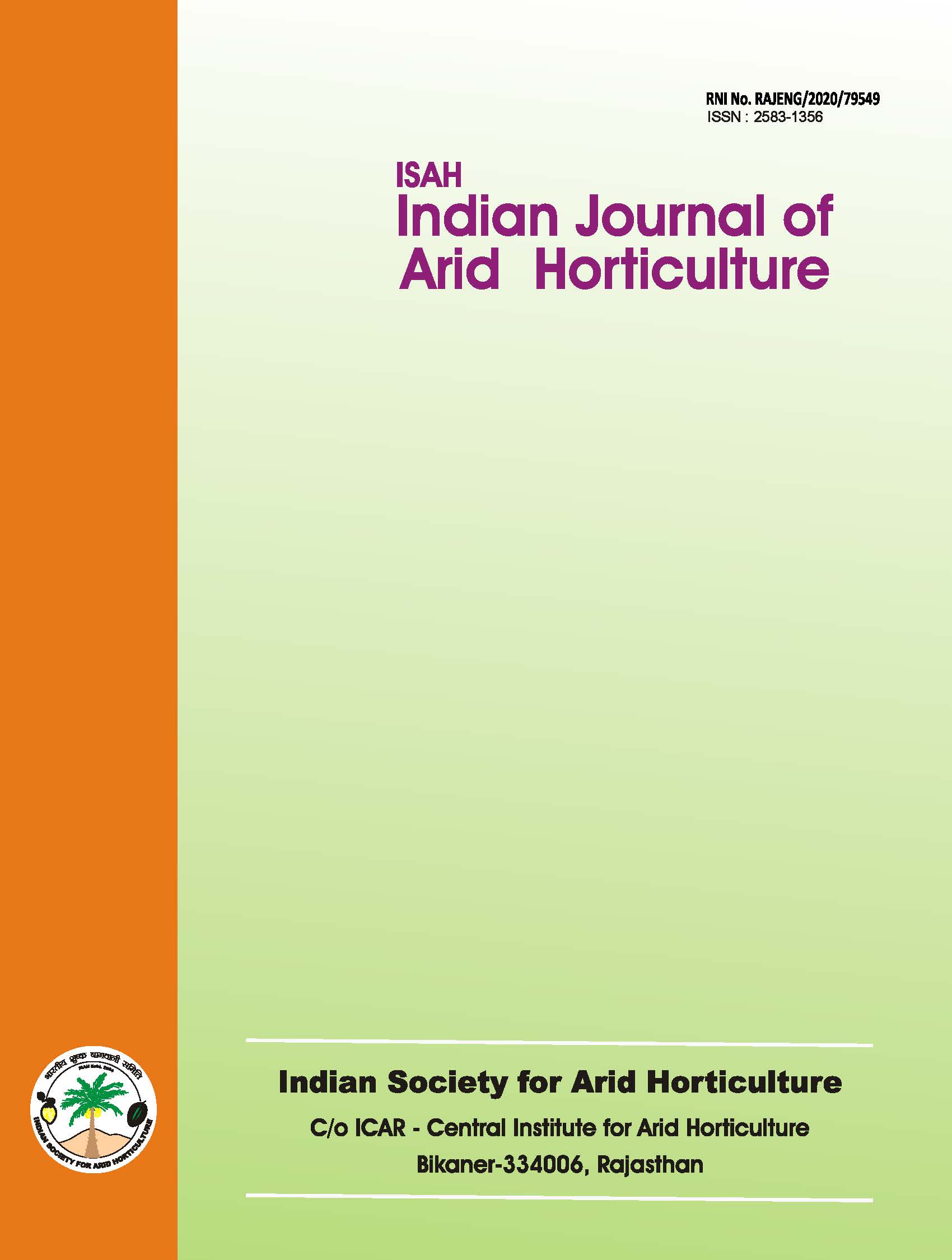Determinants and restraints in production of snapmelon (Cucumis melo var. momordica) at large scale in hot arid regions : A study
Keywords:
Snap melon, , technology adoption, socio-psychological determinantsAbstract
The pl'esenl study was conducted in Bikantr. Nagaur ::ind Chun..t distriCL'- of WeStern Raj:.1stlu111 duriog 2013 - 15. Random method of s:i.nlpling was used to make toll.ll s::uuple size of 108 responde.nts (sn:lp melon growers) for the study. Further, the selected respondems were personally conu1c1ed and interviewed one by one to a.s...�ss the detem1inants which enc-ourage (c-ompel the farmers to adopt and grow snaprnelon crop at large scale on their fields. Simultaneously, the factors whic.h resu·aio adoptioo and production of �nap melon crop al large scale were also collected to analyse and d..awing ioferences oft.he study. There found deteteminat� which lead to encourage farmers for adoption and production or snap melon (Cm:,m,is melo var. uu,mortlic:a) at large scale in hot arid regions of llle westem Rajasthan. Among such detemiinant� major were:" low water requirement of the Cl'Op, accessibility of drought escaping local va1·ieties, very �hort duration crop and easy in cultivation and harvesting. acute shortage of vegetables and substitution for dwellers. likeness of thl.! dwellers as a food .-;Luff and daiJy clicIary i1em. uscabll.! Lhro11gJu:,u1 Lhe year hi Lhe fonn of dehyclra1cd products (clry slice) and easiness in prepal'ation vegetable and other dishes. high demand in localities/ local markecs/m,mdies. cheapesc source of vege-Lable-s for au. long shelf life or the fresh fruits a1 room 1empera1ure, the snaprnelon is mos1 sui1t1ble crop i_n cxjs1iog clfrna1ic conditions. i1 can grow with low soil moisture/very low rainfall, has high drought tolerant & escapi_ng capacity, it is a imponanI component ex.isting cmpping sys1em. e1c. On the other hand, the major resIraiotS (constrain1s) which hindcn:-d Ibc adoption arnl production of snap melon in hot t1rid regions Wl.!l'c at IMgc SC�l_l� sc.nrcity of wall.!r, very low and erra1ic rainraU. occurrence of drought very fret1uently. very deep and poor quality of ground water, unfamiliarity with improved producLion technologies. lack of viable schemes aod support system., poor markeLing and market intelligence system and poor ex1.ension and ioformation system. etc.Downloads
References
Magray, M. M., Jabbic, N., Chall(K), M. A., Parray, F. A., Shabir, A., & Kamali, S. N. (2014). Various problems of dryland agriculture and suggested agro-techniques suitable for dryland vegetable production. International Journal of Applied Science and Engineering, 2(2), 45–57.
Maini, S. O. (1997). Value addition to horticultural wastes. Indian Horticulture, 42(2), 73–78.
Meena, S. R., Singh, R. S., Sharma, B. D., & Singh, D. (2016). Most favorite traditional cucurbitaceous vegetables and their utilization pattern in the Thar desert of western Rajasthan, India. Indian Journal of Traditional Knowledge, 15(3), 385–394.
Meena, S. R., More, T. A., Singh, D., & Singh, I. S. (2009). Arid vegetable production potential and income generation. Indian Research Journal for Education, 9(2), 72–75.
Singh, J. P., Beniwal, R. K., & Yadav, N. O. (2004). Ethnobotanical importance of cucurbits in India. In P. L. Saroj, B. B. Vashishtha, & D. G. Dharmdhir (Eds.), Advances in Arid Horticulture: Present Status (Vol. 1, pp. 203–219). International Book Distributing Co., Lucknow.
Yadav, N. O., & Soni, M. L. (2008). Integration of horticultural crops into farming systems in the hot arid zone of western Rajasthan. In T. A. More et al. (Eds.), Hi-Tech Production of Arid Horticulture (pp. 367–371).
Zelleke, A., Momiam, B. G., Jager, A., & Verhaegh, A. P. (Eds.). (1991). Role of research for agricultural development in Ethiopia. Acta Horticulturae, 270, 189–196.

